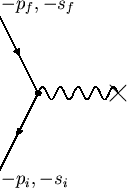 |
We now consider the scattering of positrons in a Coulomb field. We expect the form to be similar to the Coulomb scattering of an electron.
The ![]() -matrix for the process in figure 7.3 is
-matrix for the process in figure 7.3 is
| (7.80) |
Here the incoming state is in the future and is to be interpreted as a
negative-energy electron of four-momentum ![]() running backward in
time.
Putting in plane waves to lowest order, the wave function is
running backward in
time.
Putting in plane waves to lowest order, the wave function is
| (7.81) |
Similarly, the outgoing state is the negative-energy electron running backward into the past. Its wave function is
| (7.82) |
representing the incident positron with momentum ![]() and
polarization
and
polarization ![]() before the scattering.
The
before the scattering.
The ![]() -matrix becomes (cf equation 7.30)
-matrix becomes (cf equation 7.30)
| (7.83) |
By the same calculation as in equation 7.45, we find the differential cross-section is
| (7.84) |
Again the spin sum may be reduced to a trace, using the relation for positron spinors
| (7.85) |
The first minus sign comes from the normalization of the negative-energy spinors and the relative minus sign of the two terms comes from the negative-energy projection operator.
The differential cross-section now becomes
| (7.86) |
This is the same as the result of equation 7.50 for the electron
with ![]() replaced by
replaced by ![]() .
Since our answer for electron scattering was even in
.
Since our answer for electron scattering was even in ![]() , this
shows that the positron scattering cross-section is equal to the
electron scattering cross-section in lowest order of
, this
shows that the positron scattering cross-section is equal to the
electron scattering cross-section in lowest order of ![]() .
.
We could have anticipated this result from charge conjugation invariance. We could equally well write
| (7.87) |
which leads to the same results as before.
In this picture the positron runs forward in time and
![]() is the wave function of the initial positron.
is the wave function of the initial positron.
Previously we saw that for each solution of the electron in the
potential ![]() there is a corresponding solution of the positron in
the potential
there is a corresponding solution of the positron in
the potential ![]() , that is, the scattering of an electron from
the potential
, that is, the scattering of an electron from
the potential ![]() is the same as that of a positron from
potential
is the same as that of a positron from
potential ![]() ; however, since the calculated cross-section
depends only on
; however, since the calculated cross-section
depends only on ![]() , the sign of
, the sign of ![]() does not matter.
This is not true for the
does not matter.
This is not true for the ![]() correction which comes from the product
of the first- and second-order scattering amplitudes, which have
opposite signs for electrons and positrons.
correction which comes from the product
of the first- and second-order scattering amplitudes, which have
opposite signs for electrons and positrons.
We may also observe that the positron cross-section is obtained from
that of the electron by replacing
![]() ; this is a
general feature of positron theory called the ``substitution rule'',
which is closely related to the propagator picture we have developed.
; this is a
general feature of positron theory called the ``substitution rule'',
which is closely related to the propagator picture we have developed.